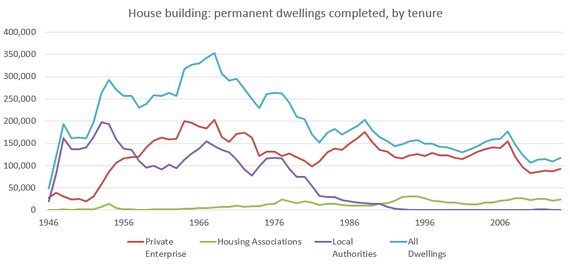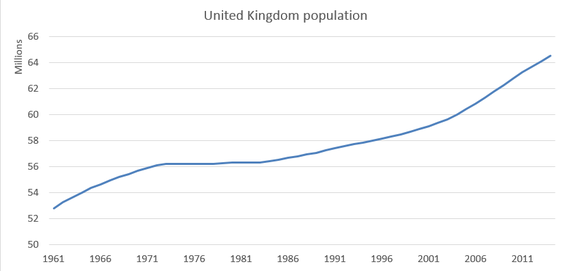The gap between supply and demand of housing is growing, pushing up prices and rents. Graduates are being priced out of the capital and first-time buyers are finding it more and more difficult to save a deposit.

The graphs below explain the problem. The first one shows the number of new homes being constructed in the U.K since 1946. Local authorities significantly reduced their contribution to these numbers in the 1980s and housing associations or private enterprise hasn't picked up the slack.

Source: Office for National Statistics
The second graph shows a 20% growth in the U.K's population since 1961. The number of new homes constructed the UK has not kept pace with the growth of its population.

Source: World Bank
Increasing demand and lack of supply is leading to increased property value. The Royal Institution of Chartered Surveyors estimate that house prices will grow by 6% in 2015, so housebuilders are doing fine.
In 2004 the Barker Review of Housing Supply found that there was a significant shortfall in the number of new homes being constructed in the U.K. It found that 240,000 new homes needed to be constructed each year to stop spiralling house prices and plug the gap in affordable homes. That target has been missed every year, despite Labour goal setting in 2007.
What are the solutions? New Labour leader Jeremy Corbyn has stated his intention to establish a National Investment Bank to help build at least 240,000 homes a year. The Conservative government has aimed to build a million new homes by 2020. How can this be delivered?
Local Authority Building
Since the 1980s and Right to Buy, local authorities have failed to build enough new properties to maintain their housing stock levels, leading to increased demand for private rentals and housing benefit. Now the government is encouraging them to build by increasing their borrowing powers.
Detractors have called this a 'solution of the past' however, as it fails to take into account modern aspirations and conditions. Living in council housing has become stigmatised and few would want to replicate the tower blocks and concrete estates of 60s and 70s.
There is also strict eligibility criteria for local authority social housing or shared buy schemes. As long as these are in place those on middling incomes or those who aren't public sector keyworkers would be excluded.
The housing charity Shelter suggests expanding local authority building in partnership with local small to medium building companies, with housing developments covering properties from social housing for those on low incomes to shared ownership for middle earners.
Encourage brownfield building
Increasing the amount of housing built on brownfield areas has been at the centre of government housing policy. The idea is popular as it is meant to encourage regeneration of urban areas which were previously used commercially or industrially but have fallen into disuse and obviate encroaching onto greenfield sites.
Eric Pickles, Secretary of State for Communities and Local Government, says that there are enough brownfield sites to build 200,000 homes. But these sites aren't without problems. Some are in unattractive, semi-industrial areas, while others are seriously contaminated, needing expensive clean-up before they are fit for residential use. There's also evidence that brownfield development is more damaging to wildlife than building on agricultural land.
Brownfield developments will also increase an area's population density, which can create a strain on local infrastructure and facilities such as schools, doctor's surgeries, roads and parking.
However, even if all the available brownfield sites were developed it still wouldn't be enough to supply the 240,000 new homes needed each year according to the Barker Review.
Relaxing planning laws
A factor slowing down brownfield and other developments is Britain's restrictive planning laws. In particular, they make building on greenfield areas difficult and reward mediocre design, while not preventing problems like increasingly tiny houses.
Under the terms of the 1947 Town and Planning Act taking into account how a planning decision will affect local housing costs is explicitly forbidden. It also protects the greenbelt around London, which often pushes housing development outside it, forcing people into dormitory communities in surrounding counties and consequent long commutes.
Nick Boles, the Planning Minister, has mooted that it might be necessary to relax planning laws to facilitate a large-scale building programme, particularly in the green belt, which would ease the housing shortage in London and the South East. This has attracted widespread condemnation from the powerful countryside lobby, who look set to oppose any attempt to develop this area.
Building new garden cities
In 2013 Nick Clegg proposed building three new garden cities to help alleviate the housing shortage, New Lib Dem leader Tim Farron has gone even further to put forward a plan for ten new garden cities.
If this became reality, the cities would be planned in areas where there is already strong housing demand, such as Buckinghamshire, and built as communities, attracting businesses to the area. Located in the Home Counties within reach of the capital, these new cities could prove attractive to London-based businesses who are struggling to recruit skilled staff in London owing to the high cost of living.
As with the cities created in the early twentieth century, such as Welwyn Garden City and Milton Keynes, they would reduce housing demand in London while being desirable domiciles in their own right.
Despite concern from organisations like the Campaign to Protect Rural England that these cities would irreparably damage the British countryside's character, only 7% of the country is currently urbanised. Harding points out that these cities would enable sustainable, attractive developments that avoid tacking new development onto existing towns while failing to increase appropriate infrastructure. These cities could face considerable opposition to development from existing communities in the area and environmentalists.
The UK needs new homes being constructed on a scale similar to that of Macmillan in the post-war period. Wider opinion is shifting in favour of increased house building; in 2014 47% of people supported home building in their area, compared to 28% in 2010.
Image sourced under Creative Commons licence.